DRL lamps: device, characteristics, selection rules
The DRL lamp, which remains popular, is a representative of gas-discharge lighting devices, characterized by a rich luminous flux and durability.Products containing mercury have proven themselves in the installation of artificial lighting of streets and industrial facilities.
However, a number of technical and operational nuances prevent them from being used in everyday life and cast doubt on their appropriateness for use in other areas of life. You will learn everything about high-pressure gas-discharge lighting devices from our article. Our tips will help you choose the right devices.
The content of the article:
- Mercury lamp device
- Operating principle: the essence of transient processes
- Application specifics: pros and cons of lamps
- Selection criteria: assessment of technical indicators
- Which manufacturer should you prefer?
- Comparison of DRL light bulbs with analogues
- Requirements for disposal of mercury devices
- Conclusions and useful video on the topic
Mercury lamp device
DRL lamps are classified as high-pressure gas-discharge devices. The priority area of use is lighting of streets, enterprises, garages and industrial workshops. DRLs are used where a powerful luminous flux is needed, and there are no special requirements for the quality of color reproduction.
Main functional parts:
- Flask. The outer shell of the device is made of heat-resistant glass. Inside there is a quartz burner to which conductors are connected. The electrodes are joined to the cathodes by connecting opposite polarities to a carbon resistor. Air has been pumped out of the flask, nitrogen has been pumped in, and the inner surface is coated with phosphor.
- Base. Responsible for receiving electricity from the network by connecting a point and threaded contact to a socket mounted in the lamp.
- Quartz burner. The main functional element of a mercury lamp.Structurally, it is a quartz flask in which electrodes are placed on both sides: two main ones and two additional igniting ones.
The space of the flask under pressure is filled with an inert gas, which ensures insulation of heat exchange between the internal environment and the burner. Additionally, literally a drop of mercury is added there. When cold, the mercury compound looks like a coating on the flask or has the shape of a ball.
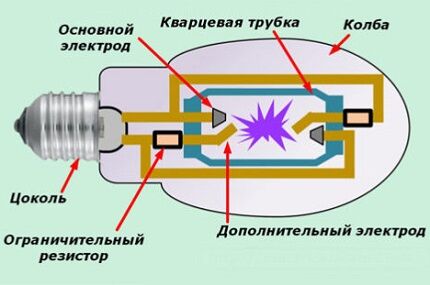
Operating principle: the essence of transient processes
The action of a mercury arc lamp is based on the processes of electrical discharge in a gaseous medium, occurring in a bulb under high pressure. This generates a glow source similar to the spiral in an incandescent light bulb. But it is not a hot tungsten filament, but a cord of glowing mercury vapor, “stretched” between the electrodes.
The persistent glow of the DRL lamp begins 8-10 minutes after energy is supplied. During this time, the current flowing in the lighting device is higher than the rated value, and is limited by resistance ballasts.
The start-up duration depends on the ambient temperature - the colder it is, the longer it takes to “warm up” the lamp. After switching on, the mercury slowly evaporates when heated and gradually intensifies the discharge between the working electrodes.
When the mercury component is completely converted into gaseous form, and the pressure inside increases, the light bulb will reach maximum light output.
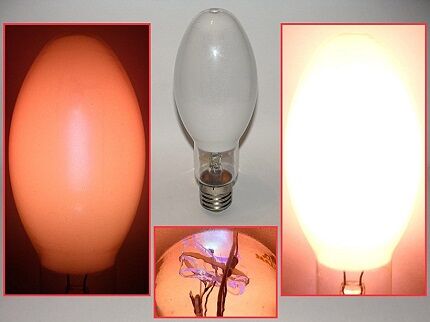
A voltaic arc in mercury vapor creates a glow of unacceptable color rendering, predominantly blue-green shades. The phosphor is responsible for converting UV radiation into red tones of light. Combining colors gives the white cool glow of a DRL light bulb.
Application specifics: pros and cons of lamps
DRL type illuminators are mainly installed on poles to illuminate streets, roadways, park areas, adjacent areas and non-residential buildings. This is due to the technical and operational characteristics of the lamps.
The main advantage of mercury-arc devices is their high power, which provides high-quality lighting of spacious areas and large objects.
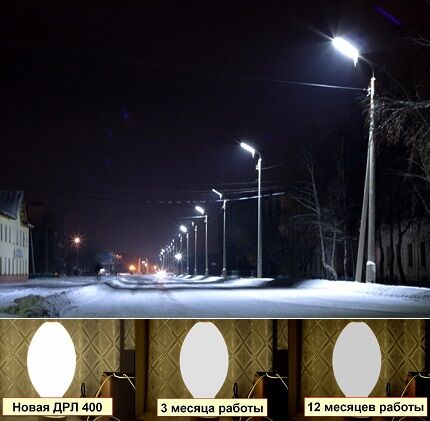
Additional benefits include:
- Durability. The average operating life declared by manufacturers is 12 thousand hours. Moreover, the more powerful the lamp, the longer it will last.
- Work at low temperatures. This is a decisive parameter when choosing a lighting fixture for the street. Gas-discharge lamps are frost-resistant and retain their performance characteristics at sub-zero temperatures.
- Good brightness and lighting angle. The light output of DRL devices, depending on their power, ranges from 45-60 Lm/V. Thanks to the operation of the quartz burner and the phosphor coating of the bulb, a uniform distribution of light with a wide scattering angle is achieved.
- Compactness. The lamps are relatively small, the length of a 125 W product is about 18 cm, a 145 W device is 41 cm.Diameter – 76 and 167 mm respectively.
One of the features of using DRL illuminators is the need to connect to the network via throttle. The role of the intermediary is to limit the current feeding the light bulb. If you connect a lighting device bypassing the choke, it will burn out due to the large electric current.

A number of disadvantages limit the use of DRL lamps in everyday life.
Significant disadvantages:
- Duration of ignition. Reaching full illumination – up to 15 minutes. It takes time to heat up the mercury, which is very inconvenient at home.
- Sensitivity to the quality of power supply. If the voltage drops by 20% or more from the nominal value, it will not be possible to turn on the mercury lamp, and the glowing device will go out. When the indicator decreases by 10-15%, the brightness of the light deteriorates by 25-30%.
- Noise during operation. The DRL lamp makes a buzzing sound, not noticeable on the street, but noticeable indoors.
- Ripple. Despite the use of a stabilizer, the light bulbs flicker - it is undesirable to work for a long time in such lighting.
- Low color rendering. The parameter characterizes the reality of perception of surrounding colors. The recommended color rendering index for residential premises is at least 80, optimally 90-97. For DRL lamps, the indicator value does not reach 50. With such lighting it is impossible to clearly distinguish shades and colors.
- Unsafe use. During operation, ozone is released, so when using the lamp indoors, a high-quality ventilation system is required.
In addition, the presence of mercury in the flask itself poses a potential hazard. These bulbs cannot simply be thrown away after use. To avoid polluting the environment, they are disposed of appropriately.
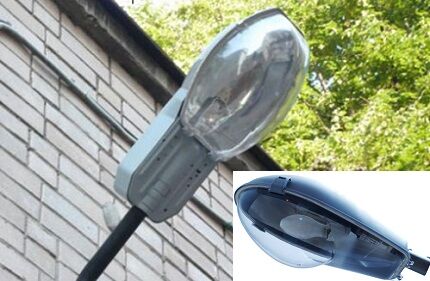
A significant disadvantage of DRL illuminators is the impossibility of turning them on again until the lamp has completely cooled. When the device is operating, the gas pressure inside the glass flask increases greatly (up to 100 kPa). Until the lamp cools down, it is impossible to break through the spark gap with the starting voltage. Restart occurs after about a quarter of an hour.
Selection criteria: assessment of technical indicators
When determining the optimal lighting fixture, you should take into account the following characteristics:
- power;
- shape/size of the base;
- luminous flux brightness;
- duration of work.
Power. When choosing this option, you should focus on the purpose and location of the lamp. If a device is purchased to illuminate the road, then you need to take into account the distance between the lamps - the greater it is, the more efficient the lamps should be.
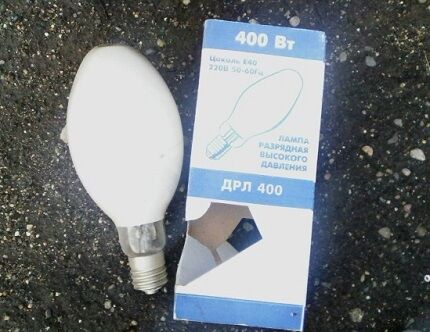
Light flow. The main indicator of light radiation directed in different directions. The parameter is measured in lumens (Lm). It is by this criterion, and not by power, that it is necessary to compare the performance of different types of lamps.
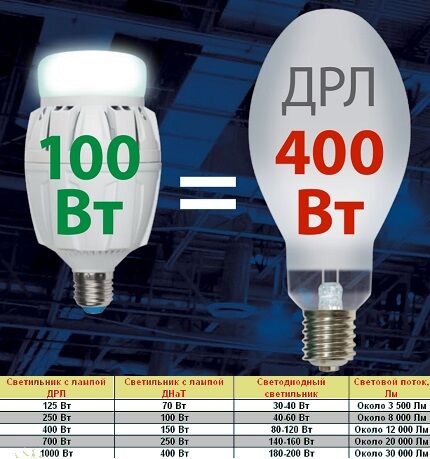
Significant savings on energy resources are a strong argument in favor of LEDs. The high cost of LED lamps pays off in the first year of operation.
Base. DRL illuminators are available with the two most popular types of bases:
- E27 – screw shape, diameter – 27 mm. Mercury-arc devices of 80 W and 125 W are equipped with this base.
- E40 is the largest size in the “E” category. The 40 mm base is used in lamps rated at 250 W and above, intended for lighting large areas.
In addition to the type of screwing into the socket, you should also take into account the dimensions of the lamp shade.

Duration of service. This parameter is largely determined by the quality of workmanship, namely the responsibility of the manufacturer. It is better to choose lamps with a maximum service life. As a rule, high-power devices have a longer service life.
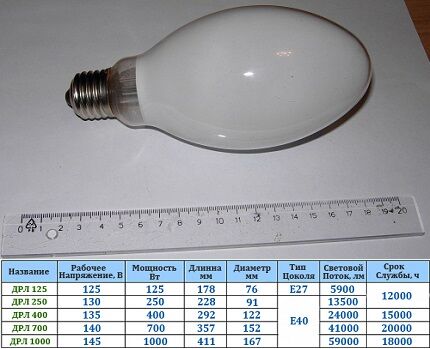
Some information about the characteristics of lamps is included in the labeling. In domestic practice, the letter abbreviation denotes the name of the illuminator, and the digital abbreviation denotes power. The production of mercury lamps is regulated by GOST 27682-88 and GOST 53074-2008.
Foreign products of the DRL type are marked QE according to the international ILCOS system.Some manufacturers adhere to the pan-European ZVEI and German LBS designation order.
Markers for mercury lamps from popular companies:
- HPL – Philips;
- HRL – Radium;
- MBF – General Electric;
- HQL - Osram;
- HSL and HSB – Sylvania.
Additional designations according to ILCOS: QB – models with built-in ballast, QG – spherical bulb, QR – lamps with a reflective inner layer.
Which manufacturer should you prefer?
It is recommended to choose products from well-known brands; it is better to refrain from buying cheap “nameless” Chinese light bulbs.
The following manufacturers have won the trust of buyers mercury devices:
- Osram (Germany);
- Philips (Netherlands);
- General Electric (USA/Hungary);
- Next (Poland);
- Eurosvet (Ukraine);
- Lisma (Russia);
- DeLux (China).
In the European market, two brands are considered leaders in the production and sale of lighting products: Osram and Philips. Both companies have many years of experience - more than a century, a wide range and a developed sales network.
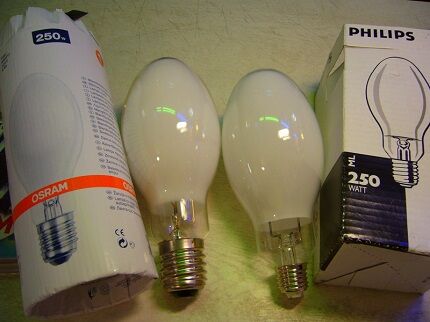
The American company General Electric has factories in Europe. The quality of the goods and service life are not inferior to previous brands, and the price is slightly lower. For a DRL illuminator with a power of 250 W you need to pay about 7 USD.
E.Next is an electrical engineering holding, where the main manufacturer of devices is the Tarel group of Polish companies. The product line includes numerous series of different lamps for home, street and industrial lighting.
E.Next 250 W illuminators, compared to German and Dutch-made lamps of similar power, are inferior to competitors in color rendering (Ra=40) and service life (12,000 hours). Approximate price – 5 USD
Mercury-arc lamps of Russian, Ukrainian and Chinese brand production are in the same price category, the average cost of products for 250 W is 3 USD. The disadvantage of lighting devices is their limited operation - according to the passport data, the light bulbs will last 5000 hours.
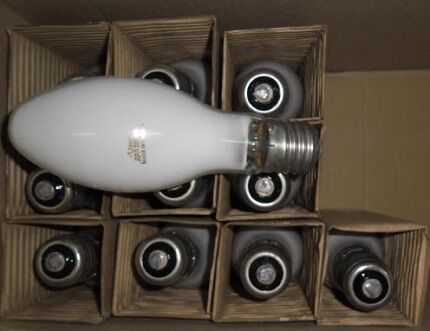
Comparison of DRL light bulbs with analogues
Discharge lamps are often compared with each other and with more profitable LEDs. The closest analogues of DRL are three types of illuminators: DRI, DRI and DNAT. Let's try to identify the features and competitive advantages of different light bulbs.
DRV. A mercury-tungsten arc lamp is very similar in design and operating principle to a DRL. Structurally, inside the flask there is a mercury discharge torch and a tungsten spiral. The last element limits the current for the burner, which means that additional ballasts are not needed.
The main differences between mercury-tungsten lamps and DRLs:
- They consume more electricity - the luminous flux of DRV 250 is no more than 5500 Lm;
- estimated operating time – 3000 hours;
- lights up within 1 minute.
DRI. Mercury arc lamps with emitting additives: indium, sodium, thalium halide, etc. Metal components increase the light output of devices to 75-90 Lm/W.
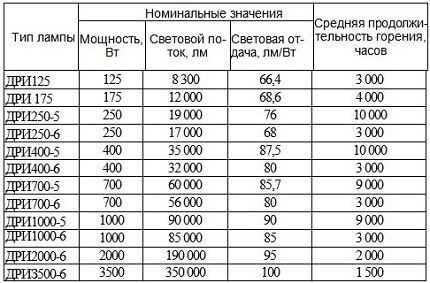
DNAT. Sodium arc lamps boast the highest light output and longest operating life among discharge illuminators. Performance sodium light bulbs over time it does not decrease as noticeably as DRL lamps.
Characteristics of DNAT:
- maximum light output – 125 Lm/W;
- operability – within 20 thousand hours;
- relative stability of parameters;
- wide range of operating temperatures;
- reaching maximum illumination in 5-7 minutes.
Disadvantages of sodium light sources: significant pulsation and low color rendering coefficient, Ra=25. The emission spectrum is dominated by red and yellow colors.
Discharge lamps are confidently giving way to LED options. LED devices they surpass their predecessors in all technical and operational parameters.
The undeniable advantages of LEDs: environmental friendliness, minimal pulsation, service life, instant switching, excellent color reproduction and contrast. In addition to excellent performance characteristics, diode devices have temperature and mechanical resistance.
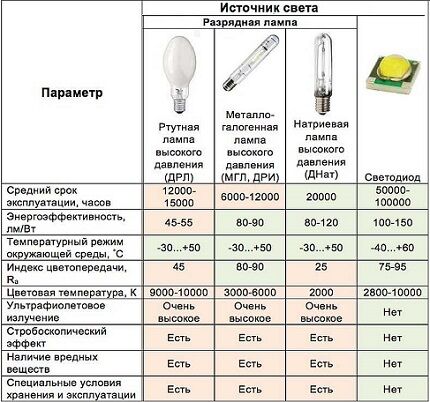
Requirements for disposal of mercury devices
You cannot thoughtlessly throw away used or defective mercury-containing light bulbs. Devices with a damaged bulb are a serious threat to human health and the environment as a whole, and therefore require specific disposal.
The question of the procedure for disposing of unsafe waste is relevant both for business owners and for ordinary residents. The processing of mercury lamps is carried out by organizations that have received the appropriate license.
The company enters into a service agreement with such a company. Upon request, a representative of the recycling company goes to the site, collects and removes the lamps for subsequent disinfection and recycling. The estimated cost of the service is 0.5 USD per lighting fixture.
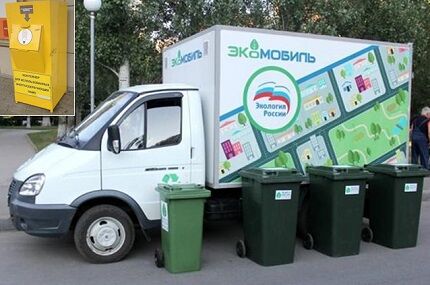
If the release mercury-containing lamps enterprises are somehow controlled by supervisory authorities, then compliance with recycling rules by the population is the personal responsibility of citizens.
Unfortunately, due to low awareness, not every user of mercury lamps is aware of the possible consequences of mercury vapor entering the surrounding atmosphere.
All types of energy-saving lamps are described in detail in next article, which examines the principles of operation, compares the devices, and provides a simplified economic assessment.
Conclusions and useful video on the topic
The proposed video review describes the design of the DRL illuminator, describes in detail the principle of operation and notes the main nuances of operation:
DRL type gas discharge lamps are still used in street lighting. The main argument in favor of mercury devices is the powerful luminous flux and affordable cost. However, they are gradually being replaced by more advanced lamps, which, along with high efficiency, boast good glow quality and safety of use.
Please write comments in the block below, ask questions and post photos on the topic of the article. Share useful information that will be interesting and useful to site visitors. Tell us about your own experience in choosing and installing a high-pressure discharge light bulb.




This is, of course, interesting, but don’t you think that these lamps have too many disadvantages? The presence of mercury and the release of ozone are very harmful to the environment. It's time to change city lighting to a more environmentally friendly option. What is the use of a lamp that takes a long time to light up, crackles and barely shines? In our city there are no collection points for the disposal of hazardous devices (mercury-containing lamps, batteries, accumulators, etc.)
Almost all populated areas have collection points for energy-saving lamps and DRL lamps, but not everyone knows about them. Any construction or hardware store, management company, Ministry of Emergency Situations. If the village is small, and there is none of the above, and it is not possible to go to the city, then you can hand over such lamps to the village administration.
Stores often refuse to accept used lamps, but this is illegal. Any such store is required to enter into an agreement with a recycling organization.
Does ozone release harm the world? Come on! Do ozone holes mean they are useful?